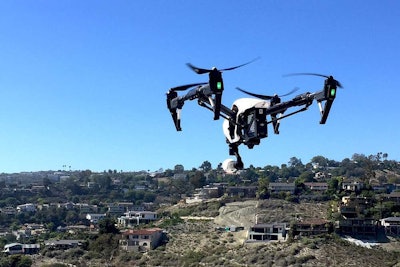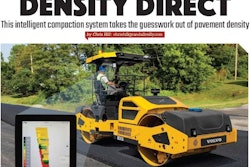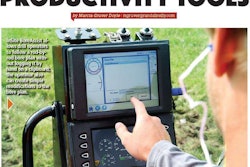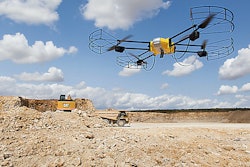

There are the obvious applications such as using the aircraft to grab aerial progress shots, but contractors like Rogers-O’Brien have figured out how to work drones deeply into their workflow. Meanwhile, at least one heavy equipment manufacturer is looking at using the real-time mapping data drones can gather as a way to allow dozers and other machines autonomously operate.
At this point the only real barrier to a company figuring out its own drone applications is receiving a Section 333 exemption from the Federal Aviation Administration for commercial use. And while those exemptions were trickling out at first, the FAA has more than quintupled the number of exemptions it has granted since July with more than 2,500 companies having been granted permission to fly as of this writing.
A sizable chunk of those exemptions went to construction and surveying companies. At last count, VentureBeat.com’s survey of the FAA’s exemption data had construction at 381 exemptions.
Below, we wrap up a busy year in drones and provide a look at the future holds.
Quick impact
By far, rotor-driven drones, those that operate like a helicopter with multiple propellers, are the most popular across all industries, and construction is no exception.
Though fixed-wing drones, those that operate more like an airplane or glider, make more sense for surveying due to their speed and superior battery life, rotor-based drones – such as quadcopters like the popular Phantom series from DJI or the new Falcon 8 from from Topcon – are more versatile since they can hover in place.
But it’s likely the drone landscape won’t stay divided between these two categories. In November, Amazon unveiled a drone prototype with a hybrid design: part helicopter, part airplane. After reaching altitude vertically with its rotor system, the aircraft’s rear propellers kick in, allowing horizontal flight.
But the great thing about this technology is that you don’t need a custom kit or an expensive setup to see it make a big impact on your business.
As reported in our September issue, Texas-based contractor Rogers-O’Brien (ROB) Construction owns a fleet of at least 10 drones and the majority of them are rather simple quadcopters made by DJI that can be had for as little as $1,000. ROB employs the footage and photos gathered by the aircraft throughout its building process, from pre-construction site plans through to the wrap-up photography it hands over to clients in the closeout phase.
ROB is also using its fleet of UAVs for weekly aerial progress photos, noting that when the firm was solely relying on aerial photography services for this job, the photos were outdated by the time they received them. “Plus, we can’t get a helicopter to hover 10 feet from a slab ledge to make sure steel indents in a facade are in the proper place,” says ROB’s Blake Potts.
How to operate legally
Compared to a year ago, businesses have a much clearer understanding where the FAA stands on the issue of drones. The agency will soon require all drones to be registered with the government before they can be flown. According to a recent proposal by an FAA drone task force, the registration process will likely be a quick online form with a registration number emailed instantly that can then be affixed to the drone before flight.
This registration will ensure the FAA knows exactly who owns a drone should it interfere with commercial aircraft or cause danger to civilians in another way.
We also know what the FAA’s rules for safe operation of drones will likely be once a final draft is issued in the next couple of years. Here are the key points:
- The drone must weigh 55 pounds or less
- Must be flown at speeds less than 100 mph
- Operator must ensure the drone stays within his/her visual line of sight (VLOS)
- A first-person camera cannot satisfy the VLOS requirement, but can be used as long as requirement is satisfied in other ways
- Cannot be flown above 500 feet
- Drone can only be flown when weather affords at least 3 miles visibility
Though a manned aircraft pilot’s license is not required, drone pilots must obtain a UAS operator’s certificate by passing knowledge test at FAA facility every two years, with a TSA check.
But until all of this becomes law, the question of legality comes down to only this: businesses who wish to operate drones, must apply for a Section 333 exemption. That’s it. And can start the application process for that exemption at www.faa.gov/uas/legislative_programs/section_333/.
Upward, onward
Perhaps the best example of this technology’s current and potential impact on construction is how it is already spawning new types of businesses around the industry’s applications.
A year ago Komatsu announced that it was launching a new drone-based service that, if successful, would transition the company from being one that supplies contractors with heavy equipment, to one that is acting as a contractor itself. (See Equipment World’s December issue.)
Dubbed Smart Construction, Komatsu’s service is pairing the intelligent Machine Control (iMC) technology found on its latest dozers and one excavator, with drones to create a fully-automated, pre-foundation site prep service. And instead of selling this technology to contractors, Komatsu is leasing the service directly to clients.
Another interesting construction focused drone company is DroneBase, a service launched this year that allows businesses to quickly hire a drone pilot.
The service is a great way for firms who aren’t sure they want to make the financial and time investment in drones quite yet to take the technology for a test drive. With just a few clicks on the company’s website, contractors can request a pilot to take either aerial photos and video of their jobsite or, for jobsites less than 50 acres in size, aerial mapping and surveying is available.
For $399, the service offers 15 to 20 high-resolution aerial photos, 3 to 4 videos and a final edited video “showing the best” of your jobsite. For those firms who have been hiring airplanes or helicopters for their aerial imagery, the savings are substantially more drastic, says DroneBase CEO Dan Burton.












